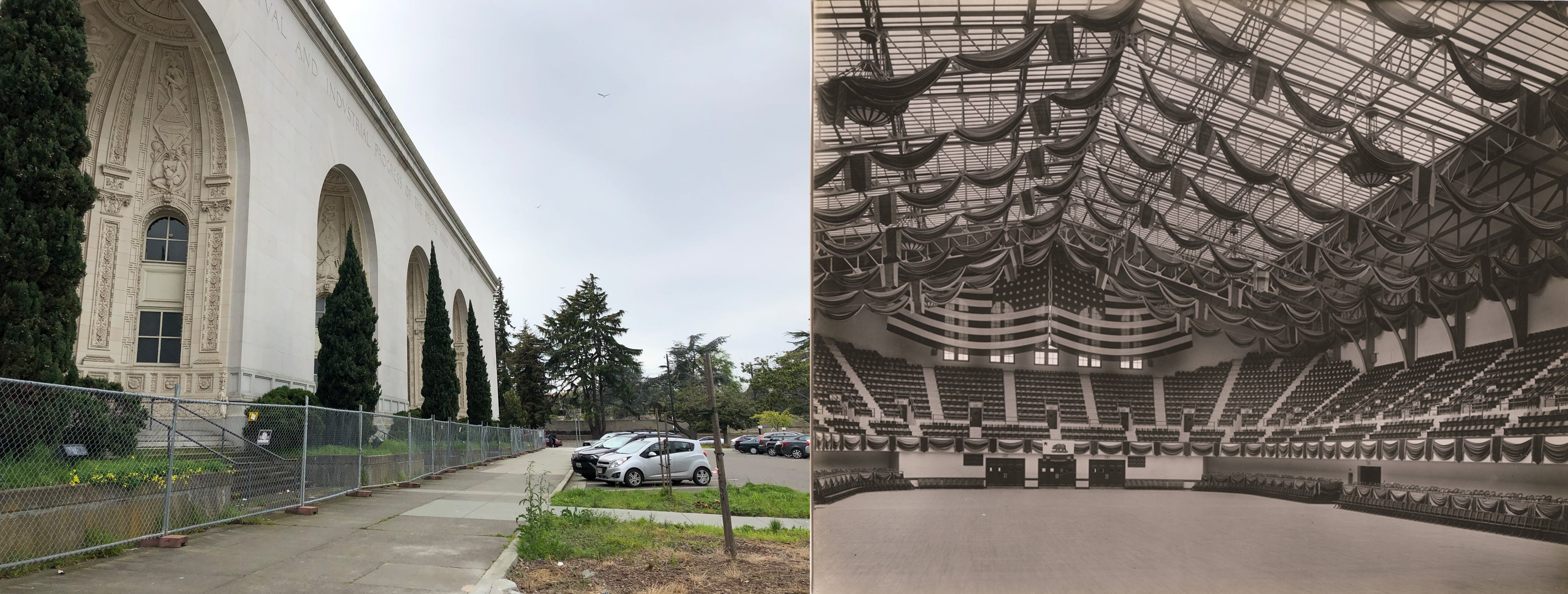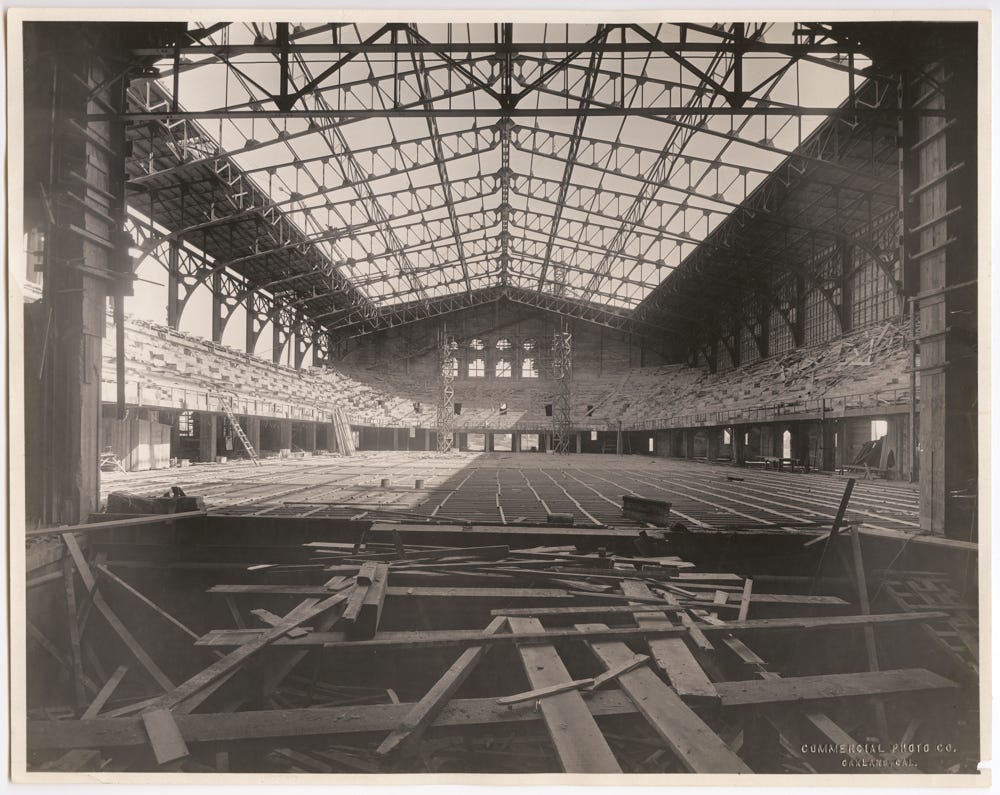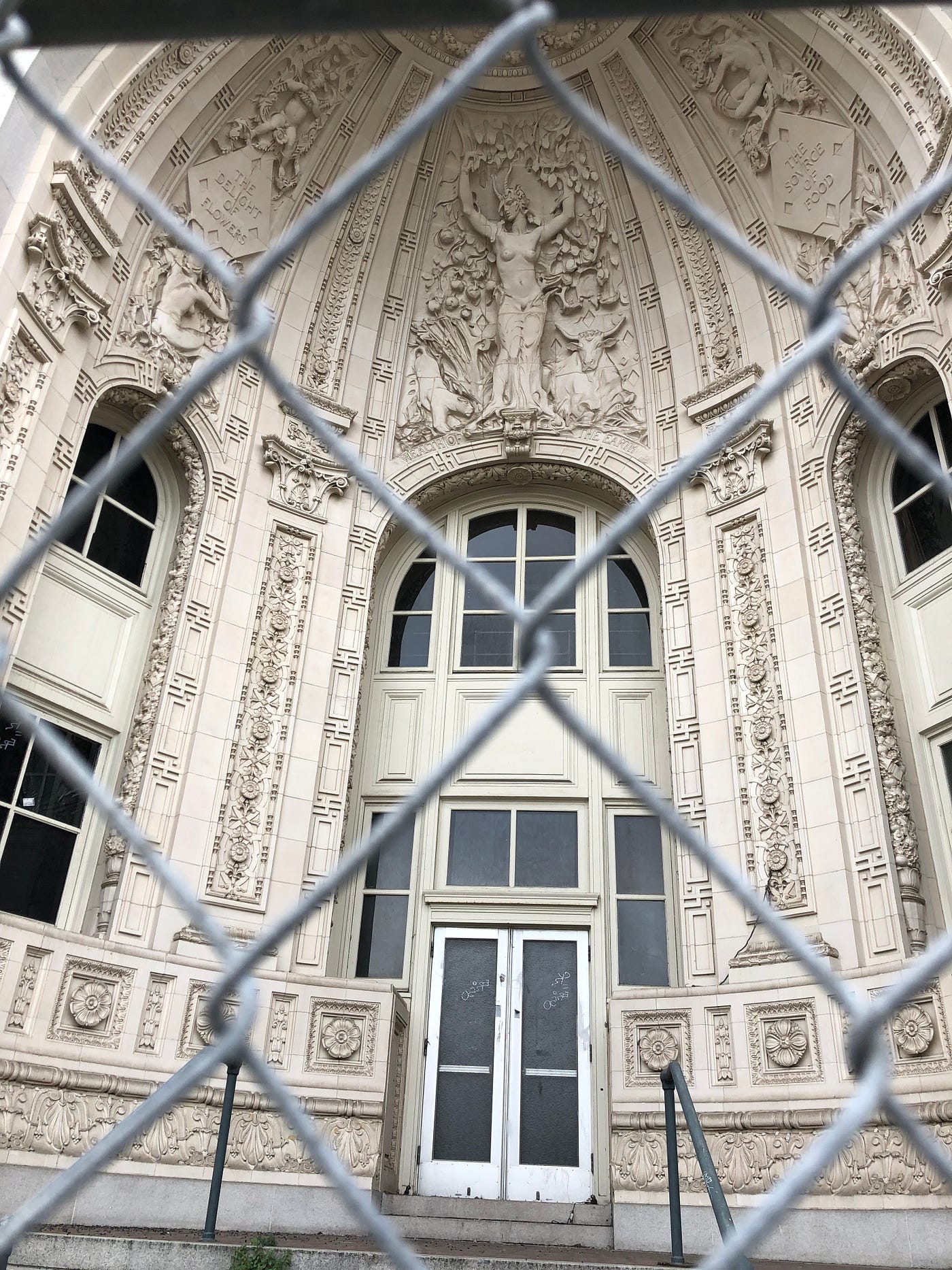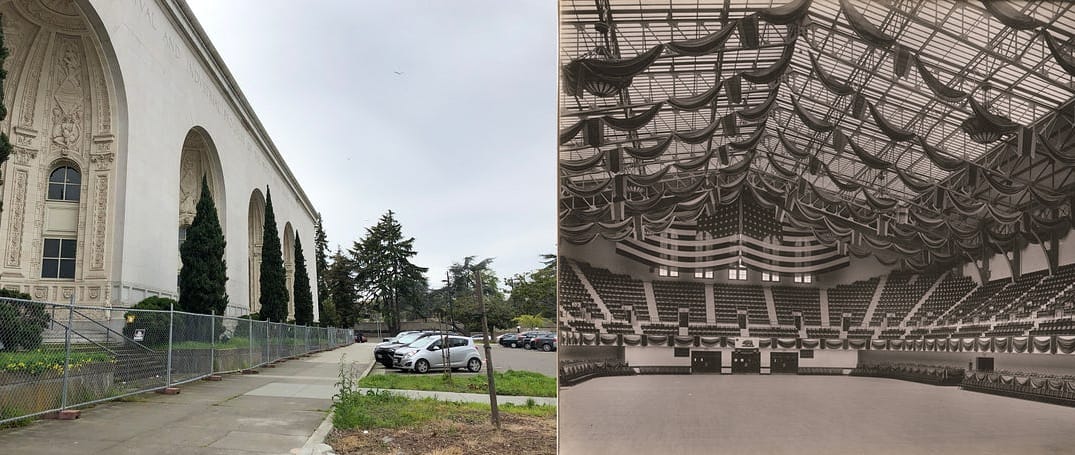
Not many cities can claim they have an honest-to-God merman carved onto the front entrance of a historic landmark — but Oakland can.
Walking by the Henry J. Kaiser Convention Center and the Calvin Simmons Theatre — originally and commonly known as the Oakland Auditorium — on the south end of Lake Merritt is like walking by a frozen piece of history. What looks like just another abandoned building from most sides tends to stop passersby in their tracks once they reach the grand front entrance. Rising above the chain-link fence wrapped in “No Trespassing” notices are seven grandiose, intricately carved archways, each unique and displaying mythical figures swirling through clouds and forests. It’s a pretty dramatic sight to behold when you realize the space is, more or less, being used only as a parking lot.
The development is simultaneously exciting and nerve-wracking for some longtime Oakland residents, as the reopened auditorium provides opportunities for community re-engagement at an end of the lake that’s been fairly quiet otherwise. However, the proposed new plans have prompted a lot of side-eyeing at which community the new space will attract.
After hosting rock concerts, educational lectures, graduations, sports games, a visit from Dr. Martin Luther King Jr. and a legendary Christmas pageant for nearly a century, the convention center officially closed in 2005 due to a financial deficit. Since then, it’s sat silent and vacant, waiting for an opportunity to be welcomed back to the community that loved it so dearly and used it so frequently. Back in 2015, Orton Development Inc. was awarded the proposal from the city to renovate the space, and after a series of design and preservation meetings, plans appear to finally be moving forward. The group hopes to receive final approval for its proposal and break ground this summer.
The development is simultaneously exciting and nerve-wracking for some longtime Oakland residents, as the reopened auditorium provides opportunities for community re-engagement at an end of the lake that’s been fairly quiet otherwise. However, the proposed new plans have prompted a lot of side-eyeing at which community the new space will attract.
The anxiety around renovating any space in the Bay is palpable. Locals want to know the what, why and how of a change before it happens, in addition to understanding whether said changes will bring in members of a new tax bracket. And with the Oakland Auditorium, there’s an added sense of loyalty and protectiveness about the communal fear.
Because historically, the Oakland Auditorium, as most still call it, has been a public space that was designed for public use — at least as far back as Oakland can remember. To lose that legacy to developer plans could spell heartbreak to a population invested in keeping the space community-centric.
The Past: “For the Intellectual Progress of the Public”

From its very beginning, the Oakland Auditorium was designed as a public space. In 1914, architects John J. Donovan and Henry Hornbostel began construction, snagging famed sculptor A. Stirling Calder while he was visiting the Bay to create sculptures for the 1915 Panama–Pacific International Exhibition. It’s Calder’s work in the seven over-the-top niches.
The niches, designed to speak to the many works of man, meant to inspire members of the public as they walked beneath them. Some are your standard public-works-style imagery — men working with geometric shapes, showing their muscles while sunrays illuminate their genius. And some are a little more out there — like the merman (fish person?) holding a perpetual strut in front of a dolphin.
“There is a cultural importance, I think, about the vision of the public realm as worth investment, and worth making it glorious and accessible,” said Naomi Schiff, a member of the board of directors for the Oakland Heritage Alliance. “This is not a utilitarian touch; it’s pretty lavish.”
While the niches are beautiful, resilient and, honestly, a little weird — just like Oakland — they’re also worth taking with a grain of historical context.
Schiff, who was on the original review committee when proposals for the auditorium came up back in 2015, has been involved in the building’s preservation for a long time. She sees the auditorium as an example of architecture that reiterates the importance of investing in public access for the long term.
And while the niches are beautiful, resilient and, honestly, a little weird — just like Oakland — they’re also worth taking with a grain of historical context.

“It’s sort of naive in a way, and quite charming,” said Schiff, reading aloud a few of the titles carved into the niches, like “Wealth of the Earth” and “Delight of Flowers.” “These are not without criticism. It’s a real white guy’s conception of stuff.”
While they were at it, the builders inscribed the auditorium with a mission statement of sorts — “AUDITORIUM OF THE CITY OF OAKLAND DEDICATED BY THE CITIZENS TO THE INTELLECTUAL AND INDUSTRIAL PROGRESS OF THE PEOPLE.”
It’s a goal it immediately began living up to.

In 1918, the auditorium was converted into a makeshift hospital during a flu epidemic, with patient beds and nurses moving across the open floor as needed. The event space was used for everything from fashion shows to basketball games to touring performances. Elvis played there in 1956, and Dr. Martin Luther King Jr. spoke there in 1962. Both the Oakland Symphony and Oakland Ballet performed in the theatre for years, having moved to the Paramount Theatre in the modern day.
The Black Panthers used the space to host community events and rallies, including an infamous moment where 10,000 bags of fresh groceries were given out to attendees. Bobby Seale, the chairman of the Black Panthers, organized the Free Huey Newton rally at the auditorium in 1968, on Newton’s birthday. Rare digitizations of this rally are available at Oakland’s African American Museum and Library.
The auditorium also hosted one of the longest-running events in Oakland’s community memory: the Christmas Pageant. From 1919 to 1987, one ambitious Parks and Recreation member, Louise Jorgensen, rounded up hundreds of school kids and coordinated them into a holiday program of an epic scale. Imagine, if you will, fairies and peppermints and reindeer parading across the stage to a packed audience of thousands.
Many local residents have fond memories of the auditorium, like Dave Siegle, born and raised in Oakland before leaving for the Vietnam War in 1968, who participated in the pageant. “I think I was only six or seven years old, and with my sister, we performed in the big Christmas Pageant, which would’ve been in the early 1950s,” he said. “We were on the main floor gently tossing a ball back and forth as toys.”
Siegle also remembers the Jerry Lee Lewis concert in 1957. As an Oakland Tribune newspaper boy, he and a few others won a contest to be onstage with Lewis during the performance.
“The place was packed with Oakland Tribune newspaper boys and some of their family members,” Siegle said. “When Jerry was singing the popular song ‘Great Balls of Fire,’ he had me stand on the piano bench while he was pounding the keys and blasting the song out!”
Kathy Kaiser, another community member, finished her first millenary course at Laney Technical in the spring of 1960, and she recalls how the class celebrated with a fashion show at the Oakland Auditorium, where they displayed their work.
“We were going to model all the hats that we had made,” Kaiser said. “We just had such a time…It made me feel beautiful.” Kaiser also remembers her sister performing as a tap-dancing fairy in the legendary Christmas Pageant.

The theatre at the Oakland Auditorium was dedicated to Calvin Simmons, a young conductor of the Oakland Symphony and the first African American man to conduct a major symphony. He passed suddenly and tragically in a canoeing accident in 1982, and the theatre was named for him shortly thereafter.
It wasn’t until 1983, however, that the Oakland Auditorium became the Henry J. Kaiser Convention Center — a name that could cause more than a little confusion given the sheer number of modern Kaiser buildings now in Oakland.
In 2001, a great amount of drama brewed as the Catholic Diocese sought out a new space for their cathedral after St. Francis de Sales in downtown Oakland was damaged in the Loma Prieta Earthquake in 1989. The new cathedral would have sat directly in front of the auditorium, blocking it from view. Schiff was part of the community group spoke out against the development. “It seemed like privatizing public property,” Schiff said.
In 2018, after the world-record-breaking premiere of Black Panther, a Marvel superhero story that begins and ends in Oakland, an anonymous resident projected “Wakanda Forever” onto the side of the building.
The outreach conducted by Schiff’s group, Coalition of Advocates for Lake Merritt (CALM), prompted a group of architects to reimagine that stretch of the Lake Merritt area, narrowing what was then a wide, hard-to-cross road, extending the park around the lake and developing the south end of the lake into its modern iteration — with a much more manageable crossing system and directly within view of the front of the auditorium.
“I feel grateful to the diocese for having created the dilemma, because that meant that people looked at this end of the lake and really thought about how it was dysfunctional,” said Schiff. “And it saved the auditorium in the sense that, if we had a big cathedral in front of it, it would have been obscured.”
Even after its closure in 2005, the auditorium remained a community hotspot. In 2012, members of the Occupy protest tried to “move in” to the building. And in 2018, after the world-record-breaking premiere of Black Panther, a Marvel superhero story that begins and ends in Oakland, an anonymous resident projected “Wakanda Forever” onto the side of the building for several days.
Most recently, the far side of the parking lot has become a temporary home for the Lake Merritt Tuff Shed community, a cluster of storage units that were set up to address Oakland’s desperate need for temporary shelters for its residents experiencing homelessness. Given ODI’s proposed renovation date of summer 2019, the future of this cluster is uncertain.
The Future: Open to the Public Once More

After a few attempts to sell the space, the City of Oakland put out a call for proposals for the Oakland Auditorium several years ago. It came down to two companies with very different plans — Creative Development Partners and Orton Development Inc., with the latter winning and successfully entering into an exclusive negotiating agreement in 2015.
Creative Development Partners’ plan, which did not pass, would have included an economic and workforce development program tied to Laney College next door, in addition to renovating the auditorium to include a “four-star, arts-integrated hotel” in the open space between the auditorium and the Oakland Museum of California with the goal of making the area a cultural hub.
The plans from Orton, however, focus entirely on the auditorium itself, with some additional redesign of the parking lot to better accommodate pedestrians between the lake, the museum and the auditorium. While specifics still need to be worked out, the plan includes restoring the Calvin Simmons Theatre to its original state, with plans to open it in time for a 2020 season. The rest of the building will change significantly, with the arena section being repurposed and renovated to accommodate nonprofit art and coworking offices. A raised platform and a proposed restaurant space will face out from the front entrance, capitalizing on the view of the lake without blocking the historical niches from the public.
Orton’s plans aren’t without criticism, however. Randolph Belle, a vice president at Creative Development Partners, disagrees with Orton’s plans for the arena portion of the auditorium.
“An arena that once hosted 7,900 people has been diminished to a private space serving a couple of hundred people at best,” said Belle, arguing that Orton’s plan for offices potentially reduces the use case for a space that previously served a large portion of the community at once.
But Orton says that its plans for the arena portion of the Oakland Auditorium will be dedicated to arts and nonprofit spaces, with no mixed-use commercial space allotted in the renovated offices. And while that’s encouraging, some wonder whether local artists will even be able to afford the rent. Orton could not confirm what those rental rates will be.
“I’m certainly hoping there will be enough profits generated that those nonprofits won’t have to pay an arm and a leg,” said Shiff, noting that the city could make efforts to offset the cost of those offices. “This is one place. Since it’s a city building, they could certainly make some demands.”
As Orton continues to seek approval for their plans in order to begin development this summer, the hope for the space is that it respects the legacy the Oakland Auditorium has created throughout the last century. And true to the heart of the city, if it doesn’t do so, the people will find their own way to recapture that purpose — come hell or strange fish-man.







